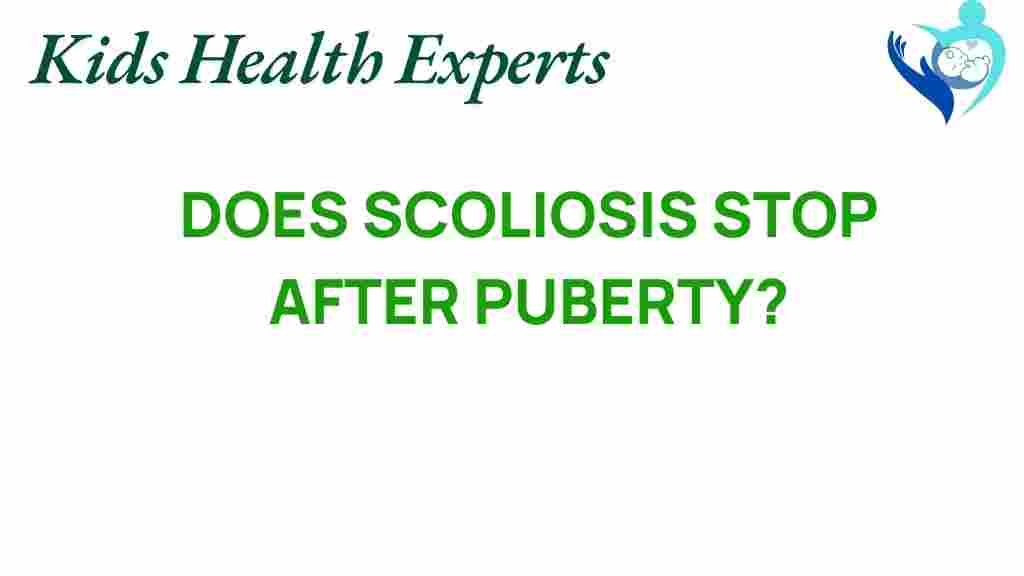The Scoliosis Paradox: Does It Really Stop After Puberty?
Scoliosis is a complex spinal condition that affects a significant number of adolescents, especially during the growth spurts associated with puberty. As children transition into their teenage years, many parents and caregivers wonder: does scoliosis really stop progressing after puberty? This article aims to unravel the misconceptions surrounding scoliosis and its relationship with growth, treatment options, and the importance of spinal health during and after puberty.
Understanding Scoliosis
Scoliosis is defined as an abnormal lateral curvature of the spine that can occur in a variety of forms and degrees of severity. In many cases, scoliosis manifests during the growth spurts of adolescence, making this a crucial time for monitoring and intervention.
Key aspects of scoliosis include:
- Types of Scoliosis: Idiopathic, congenital, neuromuscular, and degenerative.
- Symptoms: Uneven shoulders, uneven waist, one hip higher than the other, and back pain.
- Diagnosis: Physical exams, X-rays, and sometimes MRIs.
The Growth Spurts of Puberty
Puberty is characterized by rapid growth and physical changes, which can significantly impact spinal health. During this critical period, it is common for adolescents to experience increased curvature in their spine if they have a pre-existing condition like scoliosis.
Understanding the growth process is important for managing scoliosis:
- Timing: Growth spurts typically occur between ages 10 and 14.
- Hormonal Changes: Increased levels of hormones can affect bone growth and density.
- Physical Activity: Active lifestyles can help support spinal health.
Does Scoliosis Stop Progressing After Puberty?
One of the most persistent misconceptions is that scoliosis stops progressing after puberty. While some individuals may experience stabilization, others may continue to see changes in spinal curvature. Factors that influence this include:
- Severity of Curvature: More severe curves are at a higher risk of progression.
- Type of Scoliosis: Idiopathic scoliosis often stabilizes, but other types may not.
- Individual Growth Patterns: Each adolescent grows at a different rate, which can impact scoliosis.
Importance of Early Detection and Treatment
Early detection of scoliosis is crucial for effective treatment. Here’s a step-by-step approach to managing scoliosis during and after puberty:
Step 1: Regular Screenings
Parents and caregivers should ensure regular screenings for scoliosis, especially during growth spurts. A simple physical exam can help in early detection.
Step 2: Consultation with Specialists
If scoliosis is suspected, consulting with a spine specialist or orthopedic doctor is essential. They can recommend:
- X-rays: To assess the degree of curvature.
- Physical Therapy: Customized exercise programs to improve spinal health.
- Bracing: If the curvature is significant, bracing may be recommended to prevent further progression.
- Surgery: In severe cases, surgical options may be considered.
Step 3: Physical Therapy and Exercise
Physical therapy plays a vital role in managing scoliosis, especially for adolescents. Engaging in targeted exercises can help:
- Strengthen the muscles supporting the spine.
- Improve posture and flexibility.
- Reduce pain and discomfort associated with scoliosis.
It is always recommended to work with a physical therapist who specializes in scoliosis treatment to develop an effective program.
Common Misconceptions About Scoliosis and Puberty
Several misconceptions exist regarding scoliosis and its progression during puberty:
- Myth 1: Scoliosis does not require treatment if it is mild.
- Myth 2: Once puberty is over, scoliosis will not worsen.
- Myth 3: Surgery is the only option for scoliosis treatment.
Understanding these misconceptions can help in better managing the condition and ensuring proper care and treatment.
Spinal Health Beyond Puberty
Maintaining spinal health is crucial not only during puberty but throughout life. Here are some tips:
- Regular Exercise: Engage in activities that promote strong back muscles, such as swimming and yoga.
- Posture Awareness: Be mindful of posture when sitting, standing, and lifting.
- Ergonomic Adjustments: Ensure that workspaces are ergonomically designed to support spine health.
- Healthy Lifestyle: A balanced diet rich in calcium and vitamin D supports bone health.
Troubleshooting Tips for Parents and Caregivers
If you suspect your child may be experiencing worsening scoliosis symptoms, consider the following troubleshooting tips:
- Track Changes: Keep a journal of any noticeable changes in posture or discomfort.
- Consult Professionals: Don’t hesitate to seek multiple opinions from healthcare providers.
- Stay Informed: Keep up-to-date with the latest research and treatment options available for scoliosis.
Conclusion
The relationship between scoliosis and puberty is complex, and the notion that scoliosis stops progressing after puberty is misleading. While some adolescents may experience stabilization, others may continue to see changes in their spinal curvature. Regular monitoring, early treatment, and ongoing physical therapy can significantly impact outcomes for adolescents with scoliosis.
By fostering a better understanding of scoliosis, its treatment options, and the importance of spinal health, parents and caregivers can empower their children to lead healthier, more active lives. For more information on scoliosis and treatment options, consider visiting this resource.
For those seeking community support and additional resources, check out this external link.
Remember, proactive measures during and after puberty are essential in managing scoliosis effectively.
This article is in the category Conditions and created by KidsHealthExperts Team
